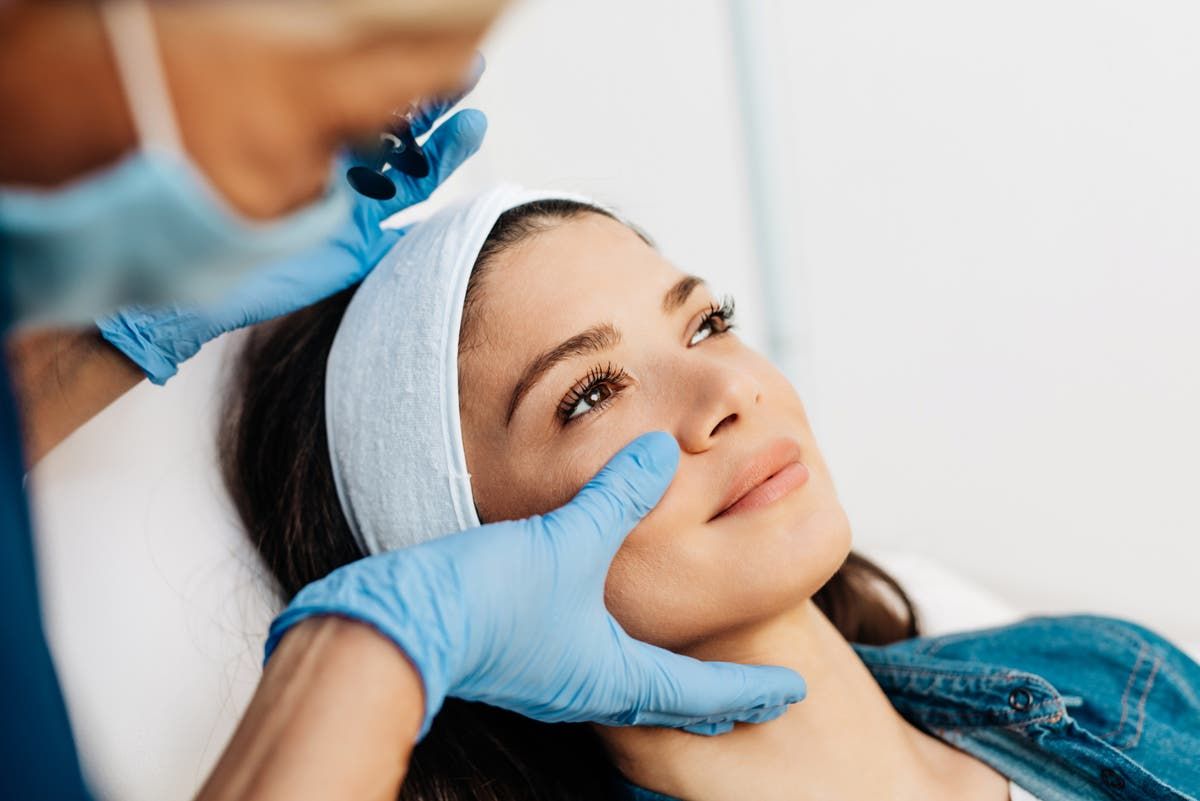W.hen I grew up in the 2000s, “Botox” seemed like a blanket term synonymous with a certain type of surgically enhanced face: frozen, swollen, unable to express emotion. But in the decades that followed, the reputation of this wrinkle-smoothing injection changed. The treatment is no longer solely associated with permanently raised eyebrows. Professionals (at least reputable ones) tend to lean toward a “less is more” approach. And it is no longer something that is whispered or considered a dirty secret.
A quick look at social media shows, for better or worse, how normalized these hits have become. But what is especially striking is the youth of those who praise Botox: they are often between twenty and thirty years old. “I had Botox as a baby and now I'm obsessed!” It's the kind of title that appears over and over again in videos of obviously young women; “come with me to get Botox for the first time” is another. Offline, I've had conversations with friends in their twenties where they've complained that they “need a Botox baby” to fix emerging lines. Many of my peers in their early thirties have already taken the plunge or are open about the fact that it's only a matter of time before they do (I know, I know: God forbid our faces show signs of wear and tear). ). .
Whether you're an image-conscious Gen Zer or a younger millennial, “baby Botox” is clearly one of the beauty buzzwords of the moment. But what does it really mean? Botox itself is a neuromodulator, a type of injectable that temporarily interrupts nerve signals to muscles, preventing them from contracting and reducing the appearance of wrinkles. There could also be a “feedback effect,” explains Naveen Cavale, consultant plastic surgeon at Real Clinic. If you freeze, say, expression lines, then you won't be able to use them, he explains. And thus “the habit of using [them]”, and slow down the process of wrinkle formation.
The term baby Botox simply refers to a slightly different application approach. “A smaller dose of Botox is used, distributed more evenly,” says Dr. Ashwin Soni, plastic surgeon and founder of the Soni Clinic. “The result is a more natural appearance, especially when people express [emotion] or encourage [their faces].” This technique, he says, is his “preferred way to apply Botox,” and has seen “a huge increase” in demand in recent years (statistics also show that our collective desire for all Botox treatments has skyrocketed recently: In 2022, the British Association of Aesthetic Plastic Surgeons reported that demand had increased by 124 percent compared to the previous year).
What makes things a little more confusing is that some professionals and clients also seem to use “baby Botox” to refer to so-called “preventive” Botox treatment. The smooth-faced young women you may see documenting their treatment process on TikTok hope that by injecting their muscles before wrinkles have properly formed, they will stop lines from forming (because, according to that “feedback effect,” they won't be able to move or use those muscles).
Soni says the youngest patient she saw for Botox was probably around 25, but she had very prominent lines when her face was at rest and they had bothered her for years. But most women her age simply don't have the kind of deep, static wrinkles that Botox is designed to eliminate. As such, Soni does not recommend “doing Botox to someone who does not have any lines to treat just for the 'preventive' element; that doesn't make any sense to me. You don't need to do it before. [wrinkles] really develop. If someone has a smooth forehead without lines at rest, there is no indication to treat it… If someone came to see me in [age] 22 and I had no lines and I was like, 'I really want Botox,' I wouldn't do that, because I don't think that's right. There's no need. Number one, it's a financial investment. But also, more importantly, you don’t have to do it for the sake of doing it.”
If someone has a smooth forehead without lines at rest, there is no indication to treat it.
Dr. Ashwin Soni, plastic surgeon
In other words, there's little point in starting injections just because you're worried you'll get a wrinkle someday: you should wait for said wrinkle to form (shock horror) and then treat it if you want. . Plastic surgeon Cavale is particularly skeptical about “preventive” treatments, because he suggests there is a chance that younger clients are preparing themselves “for bigger, riskier and more expensive treatments.” [procedures] in the future.” When we retouch our face, “every action has a reaction,” he says. So, if you can no longer raise your eyebrows, for example, then the muscles that lower them “now act unopposed, because your face is a balancing act: your 'happy' face. [expression] muscles, your 'sad' muscles.” If people begin to notice a drooping effect as a result, they may decide to undergo more invasive surgical treatments, such as a brow lift or eyelid surgery, to counteract it. “Botox and fillers are very much a gateway drug when it comes to aesthetics,” he warns, adding: “We could be pushing people to have bigger, more invasive things, because they were pushed to use these things at a higher rate.” younger age… We should not be preparing people for something they may not have needed in the future.”
Side effects like these can occur when the person holding the needle is inexperienced or doesn't properly understand the anatomy of the face: they could inject too much or target the wrong areas. Younger clients tend, as a general rule, to have less disposable income. It makes sense, then, that they would be “cost-driven” and opt for cheaper, less experienced doctors, says Soni, who often ends up seeing patients who have experienced problems after initially turning to other, less reputable clinics ( (who are also more likely to accept younger clients than someone like him would reject).
Surprisingly, you don't need to have a license to inject Botox or fillers in the UK; Last year, an industry analysis by researchers at University College London found that less than a third of cosmetic injections such as Botox were administered by doctors. The government has announced plans to introduce a licensing system, but it is currently in the consultation stages. “We, as experienced providers in this country, deal with many issues that arise from other clinics due to the safety and regulatory issues we have in the UK,” adds Soni. “And that's hard to see.”
It could be preparing you for bigger things: more surgery, more costs, more risks, more downtime.
Mr. Naveen Cavale, Plastic Surgeon
The “big problem” that Cavale has with “preventive” Botox is that “it is not sold with a health warning.” He believes professionals should tell their young clients that “this could prepare them for bigger things: more surgery, more costs, more risks, more downtime. They could be preventing one thing but they could be creating others. [issues].” He has noticed that clients are moving away from the overstuffed look (many celebrities and influencers have also documented the process of dissolving their facial fillers online) and suggests that we could “begin to see a backlash against [overuse of] Botox in the future. But I think at the moment there is still a perception that Botox is just a quick little fix.”
But if you are still determined to take Botox? Soni recommends opting for a doctor who has a good working knowledge of facial anatomy; He adds that they should offer you an in-depth consultation with your doctor beforehand (he usually meets with potential clients for about an hour). “You shouldn't leave a consultation feeling like you have more insecurities or that someone has pressured you into something,” she says. “You should leave feeling better informed than before.” Cavale adds that potential clients should be “really careful, skeptical and curious” and, above all, cautious about “believing a little bit of hype.” And another question to ask ourselves? Why are we so obsessed with eliminating any signs of aging, even before it has had a chance to take hold?












